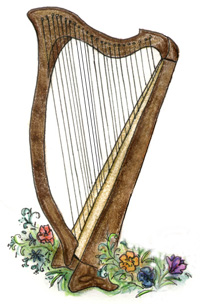If I were asked to describe my approach to harp technique in one word, it would be “ergonomic”. It’s a term that many people think of being applied to computers and other things normally found around the office: keyboards, chairs, and so on. But it’s also an essential component of playing a musical instrument without doing damage to your health.
Most non-musicians don’t realize what a demanding physical experience playing an instrument can be. But those of us who’ve been doing it for a while know all too well how easy it is to overdo it. My first rule of harping, and probably the only one that I will not yeild on, is this: If it hurts, don’t do it! No matter how accomplished and confident your teacher may seem, they should never force you to do something that causes you pain or noticeable discomfort. Everyone’s hands and bodies are different, and not all techniques work for all people. The two most widely recognized pioneers of harp technique, Salzedo and Grandjany, both had unusually proportioned hands and fingers. What was right for them might not be right for you. Any good technique should be adaptable to different physical shapes and abilities.
I have met one-handed harpists, harpists living with Multiple Sclerosis, and harpists suffering from arthristis. I have taught harpists from as young as eight to as old as sixty-eight, all with different levels of strength and stamina, size of hand, length of fingers, and so on. So if you feel like you may not be “made for the harp”, take heart! Find a teacher willing to be flexible. Keep in mind that “flexible” does not equal “lazy” – you will still have to practice regularly, and be willing to make changes if they will help to improve your playing.
More advice for avoiding injury can be found in the .beginner’s tips section of the Celtic Harp Page. I would also highly recommend checking out Laurie Riley’s books: “The Harper’s Handbook” and “Your Hands, Your Music“. If you’re self-taught, be sure to pick up a good method book or instructional video. However, keep in mind that nothing can replace having a teacher. Teachers can point out your mistakes, provide encouragement, and generally keep you on the right track where books and DVD’s cannot.
If you know of any helpful pages regarding harp technique, ergonomics, repetetive strain injuries, or other related topics, feel free to let us know if the comments, below.

